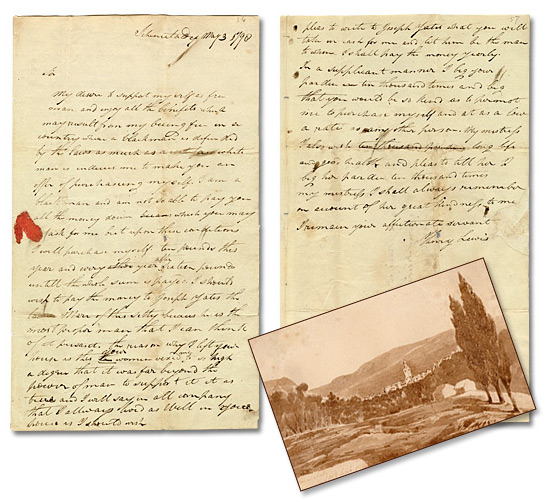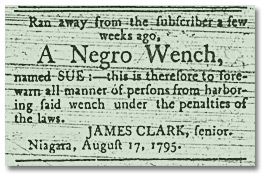
Henry Lewis escaped from his owner in Newark (Niagara-on-the-Lake), Upper Canada by fleeing to Schenectady, New York. Sometime later he wrote to his ex-owner, William Jarvis, to request he be allowed to buy his own freedom from Jarvis.
Henry Lewis's letter of 1794 provides some indication of his motives:
the reason why I left your house is this your [Jarvis' wife Hannah] vexed me to so high a degree that it was far beyond the power of man to support it is true and I will say in all company that I always lived as well in your house as I should wish.
![Photo: Unidentified man, [ca. 1875]](pics/24805_man_in_hat2_270.jpg)
Click to see a larger image (185K)
Unidentified man, [ca. 1875]
Alvin McCurdy fonds
Reference Code: F 2076-16-4-6
Archives of Ontario, I0024805

Henry Lewis letter to William Jarvis, 1798
William Jarvis Papers
Reference Code: S109 B55 PP. 56-57
Toronto Public Library (TRL)
Special Collections, Archive & Digital Collections, Baldwin Room
Schenectady, 10th Sept. 1832
Watercolour, 108 X 168 mm.
Library and Archives Canada/Dr. Nigel Davies, Gelati, Mexico (Original Source)
Acc. No. 1981-42-2 C8303471
Hannah Jarvis incorrectly wrote about the Slave Act that Simcoe . . .
"has by a piece of chacanery freed all the negroes..."
![Oil on canvas: Hannah Jarvis (Nee Owen Peters) and her daughters Maria Lavini and Augusta Honoria JArvis [ca. 1791]](pics/hannah_jarvis_children_270.jpg)
Click to see a larger image (118K)
Hannah Jarvis (Nee Owen Peters) and her daughters
Maria Lavini and Augusta Honoria Jarvis, [ca. 1791]
James Earl
Oil on canvas
Royal Ontario Museum©ROM, 981.79.2
Jarvis was the Provincial Secretary of Upper Canada, one of several in Simcoe's administration who owned slaves.
![Oil on canvas: William Jarvis with his son Samuel Peters Jarvis, [ca.1791]](pics/wm_jarvis_and_son_270.jpg)
Click to see a larger image (199K)
William Jarvis with his son Samuel Peters Jarvis, [ca.1791]
James Earl
Oil on canvas
Royal Ontario Museum©ROM, 981.79.2
Slaves Escaping
Slave owners advertised when slaves fled their service, either by offering a reward for return of the slave of warning others not to harbour or employ the recalcitrant slave.
The Reverend John Stuart from Kingston, an Anglican minister, seemed baffled that his slave fled on at least two occasions. The unnamed "negro boy" must have been desperate to get away, fleeing in such terrible weather that his hands and feet froze during the escape.
and March 4, 1803
James Ford was once a slave in the American colonies who had purchased his freedom. Much later, Ford's daughter recalled:
Matthew Elliot, a Loyalist who came from Virginia during the American Revolution, probably had as many as sixty slaves living in the huts behind his home in Fort Malden (now Amherstburg).

Click to see a larger image (304K)
Matthew Elliott homestead built in 1784 (from a photo taken in 1912)
Parks Canada Agency
Fort Malden National Historic Site of Canada

